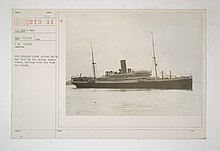 SM U-38 with crew
| |
| History | |
|---|---|
| Name | U-38 |
| Ordered | 12 June 1912 |
| Builder | Germaniawerft, Kiel |
| Yard number | 198 |
| Laid down | 25 February 1913 |
| Launched | 9 September 1914 |
| Commissioned | 15 December 1914 |
| Fate | Surrendered 23 February 1919. Broken up at Brest 1921 |
| General characteristics | |
| Class and type | Type U 31 submarine |
| Displacement | |
| Length |
|
| Beam |
|
| Draught | 3.56 m (11 ft 8 in) |
| Installed power |
|
| Propulsion |
|
| Speed |
|
| Range |
|
| Test depth | 50 m (164 ft 1 in) |
| Boats & landing craft carried | 1 dinghy |
| Complement | 4 officers, 31 enlisted |
| Armament |
|
| Service record | |
| Part of: |
|
| Commanders: |
|
| Operations: | 17 patrols |
| Victories: | |




SM U-38 was a German Type U 31 U-boat which operated in the Mediterranean Sea during World War I. It ended up being the third most successful U-boat participating in the war, sinking 134 merchant ships sunk for a total of 287,811 GRT.
Its longest serving captain was Kptlt. Max Valentiner, who was awarded the Pour le Mérite while in command of U-38. Valentiner was in command of U-38 in November and December 1915 when she sank the passenger liners Ancona and Persia; both were controversial since the ships were sunk by torpedoes without warning, in defiance of the then-current Prize rules, which stated that merchant vessels carrying passengers be given an opportunity to evacuate their passengers before being sunk.
In 1917 Valentiner was succeeded as commander of U-38 by Kptlt. Wilhelm Canaris, who decades later became an Admiral and head of the Abwehr (German Military Intelligence), in 1935–1944.